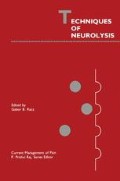Abstract
“Be the destiny of observation what it may it has seemed to me on the whole to be worth recording” noted Leonard Corning in 1885 after having injected cocaine intrathecally. Subscribing to the widely held theory of the time that a drug would act only if absorbed through blood vessels, he injected cocaine in the vicinity of the vascular leash supplying the spinal cord. The exact site of the action of the drug is open to dispute, but although the extradural space has been cited, it seems more probable in view of the small quantity of cocaine used that an accidental spinal had been performed. After Dogliotti [1] injected alcohol intrathecally in 1931 similar reports followed, but a high incidence of complications prevented universal acceptance. Maher [2] introduced intrathecal phenol in 1955, claiming it was easier to manage than alcohol and had more predictable results. Since that time, subarachnoid phenol and chlorocresol have become the two most commonly used neurolytic agents in the management of cancer pain.
Access this chapter
Tax calculation will be finalised at checkout
Purchases are for personal use only
Preview
Unable to display preview. Download preview PDF.
References
Dogliotti AM. 1931. Traitement des syndromes douloureux de la peripherie pour l’acoulisation sub arachnoidienne. Presse Med 67. 11.
Maher RM. 1955. Relief of pain in intractable cancer. Lancet 1. 18.
Bonica JJ. 1958. Diagnostic and therapeutic blocks: a reappraisal based on fifteen years experience. Anest Analg Curr Res 37. 58.
Maher RM. 1960. Further experiences with intrathecal and subdural phenol. Observations on two forms of pain. Lancet 1. 895.
Wood KM. 1978. The use of phenol as a neurolytic agent: a review. Pain 5. 205–229.
Smith MC. 1964. Histological findings following intrathecal injections of phenol solutions for the relief of pain. Br J Anaesth 36. 387.
Nathan PW, Sears TA, Smith MA. 1965. Effects of phenol solution on the nerve roots of a cat; an electrophysiological and histological study. J Neurol Sci 2. 7.
Odom CB. 1940. Epidural anesthesia in resume and prospect. Anesth Analg Curr Res 19. 106.
Bonica JJ. 1955. Role of the anesthesiologist in the management of intractable pain. Anesthesiology 16. 854.
Racz GB, Sabonghy M, Gintautas J, Kline WM. 1982. Intractable pain therapy using a new epidural catheter. JAMA 284. 579–580.
Jacobs RG, Howland WS. 1966. A comparison of intrathecal alcohol and phenol. J Ky Med Assoc 64. 408–410.
Khalili AA, Betts HB. 1967. Peripheral nerve block with phenol in the management of spasticity. JAMA 200. 1155–1165.
Katz J, Feldman DJ, Knott L, Russell AJ. 1965. Peripheral nerve block with dilute phenol solutions in the treatment of spasticity. Anesthesiology 26. 254.
Nathan PW. 1969. Treatment of spasticity with perineural injections of phenol. Dev Med Child Neurol 11. 384.
Mehta M, Ranger I. 1971. Persistent abdominal pain. Treatment by nerve block. Anaesthesia 26. 330–333.
Reid W, Watt JK, Gray TG. 1970. Phenol injection of the sympathetic chain. Br J Surg 57. 45–50.
Fyfe, T, Quinn RG. 1975. Phenol sympathectomy in the treatment of intermittent claudication: a controlled clinical trial. Br J Surg 62. 68–71.
Aids to the Investigation of Peripheral Nerve Injuries. Medical Research Memorandum (No. 45). London. H. M. S.O.
Swerdlow M. 1973. Intrathecal chlorocresol. Anaesthesia 28. 297.
Lloyd JW. Duration of pain relief in relation to length of pain prior to nerve block. Unpublished.
Hughes JT. 1970. Thrombosis of the posterior spinal artery. Neurology 20. 659.
Editor information
Rights and permissions
Copyright information
© 1989 Springer Science+Business Media New York
About this chapter
Cite this chapter
Lloyd, J.W. (1989). Subarachnoid and Other Clinical Uses of Phenol. In: Racz, G.B. (eds) Techniques of Neurolysis. Current Management of Pain, vol 4. Springer, Boston, MA. https://doi.org/10.1007/978-1-4899-6721-3_4
Download citation
DOI: https://doi.org/10.1007/978-1-4899-6721-3_4
Publisher Name: Springer, Boston, MA
Print ISBN: 978-1-4899-6723-7
Online ISBN: 978-1-4899-6721-3
eBook Packages: Springer Book Archive

